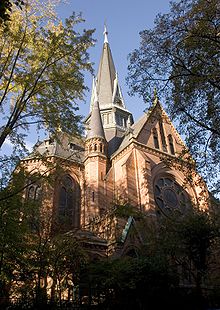Mountain Church (Wiesbaden)
The Bergkirche is the eponymous building of the Bergkirchenviertel within the historical pentagon , the center of the Hessian capital Wiesbaden .
history
The Protestant church was built in 1879 in the neo-Gothic style by Johannes Otzen , the construction management was carried out by the architect Hans Grisebach . It was the second Protestant church in Wiesbaden after the market church .
Its name is derived from its location on a higher plateau within Wiesbaden city center. The pointed slate helmet over the crossing of the mountain church can therefore be seen from afar.
Building
The interior offers paintings, glass windows and figures that are well worth seeing. Albert Schweitzer helped to rebuild the organ in 1930 .
The builder of the mountain church Johannes Otzen and the pastor of the mountain church Emil Veesenmeyer developed the so-called Wiesbaden program in 1891 , their ideas of modern Protestant church building. The central message here was to see the three elements of the service , pulpit ( sermon ), altar ( Last Supper ) and organ (music), as a unit and to arrange them accordingly, surrounded by the worshipers.
This program was implemented first in the third Protestant church in Wiesbaden, the Ringkirche , which was also built by Johannes Otzen in 1894. The fourth Evangelical Church, the Luther Church , was finally opened in 1910 according to these principles. In 1898, Otzen's pupil Fernando Lorenzen built the Kreuzkirche in Hamburg-Ottensen, a church based on the mountain church.
organ
The organ of the Bergkirche was originally built in 1879 by the EF Walcker & Cie. erected from Ludwigsburg . In 1931, the organ building company GF Steinmeyer & Co. from Oettingen in Bavaria built a new organ behind the neo-Gothic prospect of the previous organ, and some registers were also taken over. In 1948 the organ was rebuilt by the Förster & Nicolaus Orgelbau workshop from Lich . In 2016 the organ was redesigned by Claudius Winterhalter from Oberharmersbach . The instrument has 40 registers , divided into three manuals and pedal . The actions are electro-pneumatic. The disposition is:
|
|
|
|
|||||||||||||||||||||||||||||||||||||||||||||||||||||||||||||||||||||||||||||||||||||||||||||||||||||||||||||||||||||||||||||||||||||||||||||||||
- Coupling : I / II, I / III, III / II, I / P, II / P, III / P
Individual evidence
- ↑ organ Base Nl: Wiesbaden, Evangelical Church Mountain. Retrieved July 29, 2016 .
Web links
Coordinates: 50 ° 5 ′ 12 ″ N , 8 ° 14 ′ 23 ″ E


